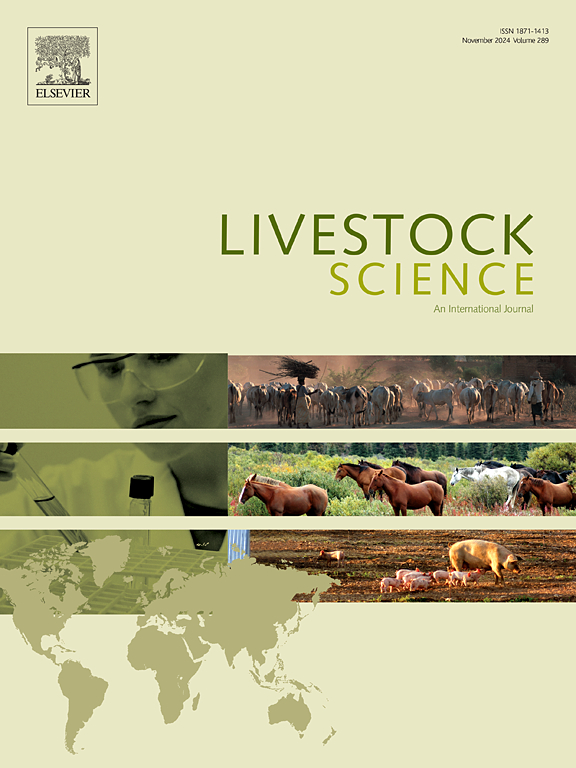低水平芒果皮和苹果果胶对仔猪体外发酵性、消化生理和微生物参数的影响
IF 1.9
3区 农林科学
Q2 AGRICULTURE, DAIRY & ANIMAL SCIENCE
引用次数: 0
摘要
食品加工的副产品,如芒果皮和苹果果胶,为猪的营养提供了宝贵的膳食纤维、果胶和各种其他有益化合物的来源。本研究的目的是探讨在猪饲料中加入芒果皮和苹果果胶的效果。利用母猪粪便进行分批发酵,在24小时的潜伏期内评估底物的发酵能力。随后,以断奶仔猪为试验对象,研究日粮中添加1%或2% (w/w)芒果皮和苹果果胶对断奶仔猪的影响。母猪粪便体外发酵研究表明,添加苹果果胶和芒果果胶可提高乳酸和短链脂肪酸浓度。饲喂试验表明,饲粮中添加1%苹果果胶对仔猪生产性能无显著影响,对粗蛋白质的表观前肠消化率没有影响,而对粗脂肪的表观前肠消化率降低,添加2%芒果果皮可提高。食糜中微生物代谢物的浓度相似,qPCR测定的细菌水平只有轻微的变化。在治疗组中,与对照组相比,粪便微生物群对芒果皮和苹果果胶的利用有所增强(BIOLOG测试)。总之,加入少量芒果皮和苹果果胶只会对仔猪的消化系统产生轻微的影响。需要进一步的研究来确定仔猪日粮中芒果皮和苹果果胶的最佳有效使用水平。本文章由计算机程序翻译,如有差异,请以英文原文为准。

Effects of low levels of mango peels (Mangifera indica L.) and apple pectin on in vitro-fermentability, digestive-physiological, and microbiological parameters in piglet nutrition
Food processing by-products such as mango peel and apple pectin present valuable sources of dietary fibre, pectins and various other beneficial compounds for pig nutrition. The study's objective was to explore the effects of incorporating mango peel and apple pectin into pig feed. Batch fermentations using sow faeces were conducted to assess the fermentability of the substrates over a 24-hour incubation period. Subsequently, a feeding experiment was conducted using post-weaning piglets to examine the impact of adding 1 % or 2 % (w/w) mango peel and apple pectin to their diet. The in vitro fermentation studies with sow faeces showed increasing lactate and short-chain fatty acid concentrations when apple and mango pectin were added as substrates. The feeding trial indicated no significant impact on piglets' performance, nor the apparent praecaecal digestibility of crude protein was altered, while the apparent praecaecal digestibility of crude fat decreased with the addition of 1 % apple pectin, but increased with 2 % mango peel. Concentrations of microbial metabolites in the digesta were similar, and only slight variations were observed in the bacterial levels as determined by qPCR. In the treatment groups, enhanced utilisation of mango peel and apple pectin by the faecal microbiota was noted compared to the control group (BIOLOG test). In summary, incorporating small quantities of mango peel and apple pectin resulted in only mild alterations within the piglets' digestive system. Additional research to determine the optimal levels for effective usage of mango peels and apple pectin in piglet diets is required.
求助全文
通过发布文献求助,成功后即可免费获取论文全文。
去求助
来源期刊

Livestock Science
农林科学-奶制品与动物科学
CiteScore
4.30
自引率
5.60%
发文量
237
审稿时长
3 months
期刊介绍:
Livestock Science promotes the sound development of the livestock sector by publishing original, peer-reviewed research and review articles covering all aspects of this broad field. The journal welcomes submissions on the avant-garde areas of animal genetics, breeding, growth, reproduction, nutrition, physiology, and behaviour in addition to genetic resources, welfare, ethics, health, management and production systems. The high-quality content of this journal reflects the truly international nature of this broad area of research.
 求助内容:
求助内容: 应助结果提醒方式:
应助结果提醒方式:


